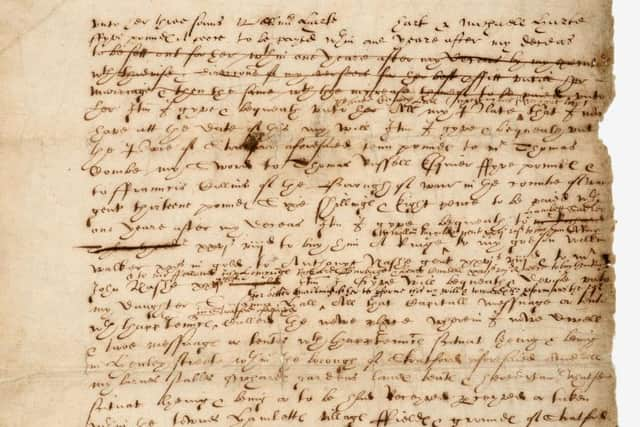Have experts solved the riddle of William Shakespeare's will?


HE may be celebrated as the world’s greatest ever playwright, but in the centuries since his death William Shakespeare has also been painted as a mean and bitter husband who chose his deathbed to exact revenge on the wife he loathed.
However, experts believe fresh examination of his will may now force scholars to reassess many of the existing assumptions about the Bard’s family life and his death.
Advertisement
Hide AdAdvertisement
Hide AdInfamously, Shakespeare left £150 to each of his daughters, more than £380,000 today, yet bequeathed wife Anne Hathaway their ‘second best bed’.


This perceived slight has previously been seen as evidence of his coldness and indifference to his wife, but now archivists believe that isn’t the case. Their scientific analysis has revealed that Shakespeare drafted the second page of the three-page manuscript at a different time – putting such gifts in a whole new light. Significant changes were made in both January and March 1616 – the year of his death – as his, and his family’s, status changed.
“Some people think the corrections and additions were mistakes or afterthoughts but as we can now date some of these to March 1616 it makes these last minute gifts more poignant,” says Dr Amanda Bevan, legal records specialist at The National Archives.
“He may have known he was dying in March and added these personal items for family and friends to what had been up until that point a very business-like document. The second best bed was certainly not a slight on Anne as the best bed would have stayed with his house.”
Advertisement
Hide AdAdvertisement
Hide AdUsing innovative techniques, experts at the British Library were able to capture images of the Bard’s will that are invisible to the human eye – and they now cast doubt over several accepted theories.


It had been thought that Shakespeare had been ill for some time and had retired to Stratford where he wrote his will as he lay dying. He was also believed to have distrusted his daughter Judith and her new husband Thomas Quiney and changed his will to stop Quiney from benefiting.
In fact, parts of the will were drawn up in 1613 and then updated in January 1616 when Judith’s marriage was imminent. Her father decided he could afford to be more generous and also look to establish a financial legacy for their future children. Far from being a resentful scrooge, Shakespeare was a canny businessman keen to secure a financial legacy for his family.
Although the results of the scientific analysis are still being examined, another early interpretation that can be drawn is that Shakespeare kept his will as a living document for updating when his, or his family’s, circumstances changed.
Advertisement
Hide AdAdvertisement
Hide AdDr Katy Mair, Early Modern Records Specialist at The National Archives, says: “You often hear it said that we don’t know much about Shakespeare; the personality behind the plays. This is just not true. The National Archives holds more than 100 documents relating to his life, both in Stratford and in London.
“This latest research adds significantly to our knowledge by revising our understanding of his will. It has been argued that he retired to Stratford as he was gravely ill but he was clearly staying engaged with business matters and other documents held at The National Archives support this theory.
“It appears he was concerned about his financial legacy and that of his family throughout his life, as shown by the redrafting of his will.
“Shakespeare was a savvy businessman as well as a successful playwright and initial findings from this new research will continue to help shape our understanding of the man.”
Advertisement
Hide AdAdvertisement
Hide AdConservators at The National Archives treated the will over a four-month period from September 2015 to January 2016, by removing a heavy paper backing and some earlier repairs made with silk, to return the document’s appearance to closer to its original state.
This allowed close analysis of the paper using x-ray technology and near infrared light for the first time.
Experts at the British Library then carried out multi-spectral imaging of the will, exposing the manuscript to ultraviolet, visible and infrared rays as a specialised camera captured images not visible to the human eye.
This April marks the 400th anniversary of Shakespeare’s death and his will is currently on display at Somerset House in London.